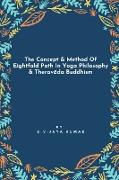The Concept & Method Of Eightfold Path In Yoga Philosophy & Theravada Buddhism
BücherAngebote / Angebote:
There are many misconceptions and misinformation about yoga and early Buddhism floating around. Many people mistakenly think for example that yoga is all about the body, while Buddhist meditation is all about the mind. Forgetting the common Indic roots of both traditions, people easily associate Yoga with India but when they think of Buddhism, they tend to think of it as an East Asian tradition. Even though the Buddha pre-dated Patañjali by some 500 years or more, yoga teachers tend to attribute a greater antiquity to Patañjali's Yoga S¿tras than is warranted, while ignoring the important historical influence of Buddhism on Indian philosophy and soteriology. If we really want to accurately understand what yogic and Buddhist practices are about then it is important that we do away with these and other misconnections to look anew at how Yoga and Buddhism might be related historically and practically. It must be remembered that both Yoga and Buddhism changed and evolved over time including - directly or indirectly - in interaction with each other. If we want to compare these systems, we have to first of all start at the beginning, i.e. we have to start with the comparison of early Yoga with early Buddhism. In this thesis, we will analyze the similarities and differences between Patañjali's A¿¿¿¿ga (Eight-Limb) Yoga and the Buddha's Noble Eightfold Path. We would ask: Did these paths emerge independently or did one influence the other? What are the similarities and differences in the practices and goals of early Buddhism and A¿¿¿¿ga Yoga? Can one help to illuminate the other? Our investigation shows that both Yoga and Buddhism have roots in non-Aryan traditions of asceticism and renunciation, which influenced the philosophical evolution of Vedic Brahmanism. We can trace the ancient roots of Yoga all the way back to the ecstatic and ascetic "muni" of the Indus Valley civilization three thousand or so years ago. As for the Buddha, he was a K¿atriya prince-turned-wandering ascetic who, two thousand five hundred years ago, discovered and taught a path to liberation via the gnostic wisdom or insight gained through a very particular path of concentration-and-mindfulness meditation. Many elements of pre-Vedic and non-Vedic ascetic traditions, including Buddhism, were later absorbed into Brahmanical philosophy, and can be seen reflected in the Upani¿ads, the Bhagavadg¿t¿, and in the six orthodox/Brahmanical schools of Indian philosophy which includes Yoga.
Folgt in ca. 15 Arbeitstagen




